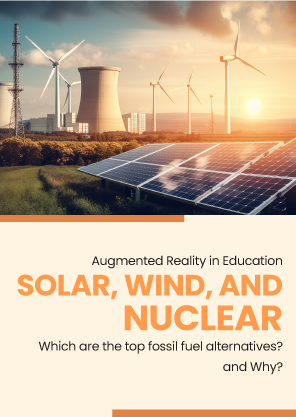or call: +1 (845) 347-8894

or call: +1 (845) 347-8894

The quest for sustainable and green energy sources has given rise to alternatives that aim to challenge the dominance of fossil fuels. While fossil fuels still hold a significant share in global and domestic energy markets, there is a growing momentum to explore and integrate cleaner alternatives. This discussion focuses on three major alternatives—Solar, Wind, and Nuclear—as they emerge as contenders in the pursuit of a more sustainable energy future.
In 2020, a big chunk—79% to be exact—of all the energy used in the United States came from fossil fuels like coal, oil, propane, and natural gas. These are the go-to sources for power, but there’s a twist. Even though they rule the energy game, things are changing. Why? Well, people are getting more worried about the environment and thinking about sustainability on a global scale.
Sure, fossil fuels have been the energy champs for a while, but now there’s a new game in town. People are looking for cleaner alternatives. Why? Because the Earth is our home, and we want to keep it nice and healthy. It’s like when you switch from using plastic to reusable bags because it’s better for the planet.
So, even though fossil fuels are like the superstar players right now, there’s a shift happening. It’s like the world is saying, “Hey, we need to find cleaner ways to power our stuff.” This shift is not just a local thing; it’s happening everywhere because everyone wants a planet that stays green and thriving. So, even though fossil fuels are leading the pack, they might not have the crown forever. People are exploring new and cleaner options for a sustainable and healthier energy future.
As we grapple with the quest for cleaner energy sources, Solar Power emerges as a leading contender, harnessing the Sun’s abundant energy to propel us toward a sustainable future.
Solar power emerges as a top fossil fuel alternative due to its promising attributes. By harnessing sunlight to generate electricity, solar systems contribute significantly to reducing our reliance on fossil fuels. The eco-friendly operation aligns with the global push towards sustainability, offering a clean and renewable energy solution.
Wind power emerges as a formidable alternative to fossil fuels, tapping into the natural forces of the wind to generate electricity. Let’s delve into the pros and cons of this renewable energy source that has gained significant traction in the quest for a cleaner and more sustainable energy future.
Wind power, by harnessing the kinetic energy of the wind, presents a promising and scalable solution for sustainable energy. While it comes with challenges such as variability in wind patterns and potential visual and noise impacts, ongoing advancements aim to address these issues, solidifying wind power’s status as a leading fossil fuel alternative in the pursuit of a cleaner energy landscape. Nuclear Power: The Controversial Clean Energy
Nuclear power stands out as a significant contender in the pursuit of a top alternative to fossil fuels. Let’s explore the pros and cons that make it both promising and contentious.
Governments play a pivotal role in shaping this landscape by offering subsidies to encourage the adoption of cleaner energy sources for both residential and vehicular use. Recognizing the economic hurdles faced by alternative energies, these financial incentives aim to bridge the gap, making cleaner options more accessible and attractive to consumers. Subsidies catalyze individuals and businesses to transition towards sustainable practices, aligning with global efforts to reduce carbon footprints.
The economic dynamics of the energy sector are evolving, and government support has become a crucial factor in driving the shift towards cleaner alternatives. By providing financial incentives, authorities contribute to leveling the playing field and fostering a more sustainable and eco-friendly energy landscape.
As ongoing research and development broaden the horizons of alternative energy, the anticipation is that economic forces will facilitate cost reductions, enhancing the competitiveness of cleaner options against traditional fossil fuels. In the pursuit of a sustainable energy future, Solar, Wind, and Nuclear power emerge as key players, each presenting distinct advantages and challenges. The relentless progress and a shared dedication to green practices are poised to sculpt a more diversified and environmentally conscious energy landscape in the foreseeable future.




